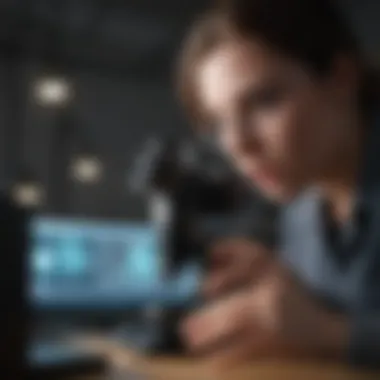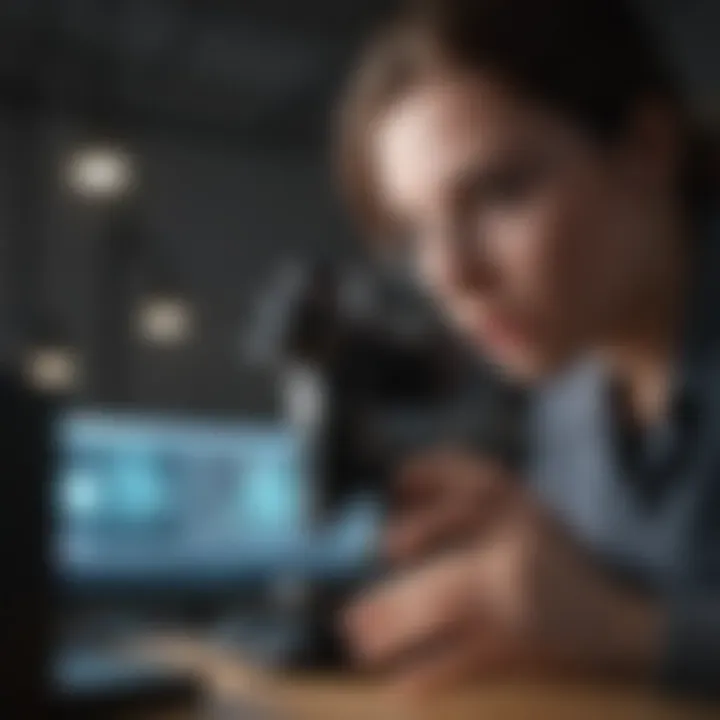Exploring Virtual Microscopes in Education


Intro
In today's rapidly evolving educational landscape, technology is taking the center stage. One of the notable advancements is the advent of virtual microscopes, an intriguing tool that has begun to reshape how students engage with scientific materials. Virtual microscopes allow learners from various disciplines to explore microscopic worlds that were once limited to physical labs. With these digital instruments, students can observe, analyze, and interact with specimens without the constraints of location or traditional equipment.
This section lays the groundwork for understanding virtual microscopes by examining their functionality, technological underpinnings, and the pedagogical benefits they bring to the forefront of science education. It serves as a gateway into a deeper discourse on the critical role these tools play in enhancing students' learning experiences and ultimately bridging the gap between theory and practice.
Key Findings
Summary of the Main Results
Virtual microscopes are more than just a digital version of their traditional counterparts. They offer distinct advantages that support educational objectives. Through comprehensive research, it has been found that:
- Accessibility: Virtual microscopes are accessible from various devices, allowing students to engage with materials anytime, anywhere.
- Interactivity: Students can manipulate images and change the focus, enhancing their understanding of complex structures.
- Cost-Effectiveness: They eliminate the need for costly physical microscopes and lab materials, making science education more budget-friendly.
- Rich Resources: Many platforms come with vast databases of pre-prepared slides and specimens, broadening the scope of study.
"Virtual microscopes provide an invaluable resource for both students and educators, fostering a more inclusive and interactive learning environment."
Significance of Findings Within the Scientific Community
The implications of these findings extend beyond the realm of education. Researchers and educators alike are recognizing that virtual microscopy is not merely a supplementary tool but an integral part of modern scientific inquiry. The emergence of these digital platforms encourages collaboration and innovation within the scientific community, as they readily accommodate diverse learning styles and backgrounds. Furthermore, by introducing students to digital microscopy at an early stage, it equips them with essential skills that align with future research demands and industry needs.
Implications of the Research
Applications of Findings in Real-World Scenarios
The insights gained from exploring virtual microscopes can be applied in numerous practical contexts:
- Classroom Integration: Teachers can incorporate virtual microscopes into their curricula to create more engaging lab experiences.
- Remote Learning: As education continues to evolve, virtual microscopes bridge the gap in distance learning situations, providing hands-on experiences even when in-person labs are not feasible.
- Public Outreach: Science museums and educational organizations can utilize virtual microscopy in exhibitions to spark interest in scientific inquiry among younger audiences.
Potential Impact on Future Research Directions
Looking ahead, the continuous development of virtual microscopy technologies can reshape educational methodologies in significant ways. As these tools evolve, they will likely facilitate a more comprehensive understanding of subjects, encouraging students to pursue STEM fields and innovations in daily life. This capability to cultivate a deeper interest in science can lead to increased participation in scientific research and collaboration across various disciplines.
In summary, the exploration of virtual microscopes is not just a passing trend, but a crucial step toward modernizing science education and fostering a new generation of informed learners and researchers.
Prolusion to Virtual Microscopes
In today’s fast-paced educational environment, virtual microscopes stand as a groundbreaking tool for students and educators alike. Gone are the days when students were confined to the limitations of traditional microscopes, peering through the eyepiece and straining to see what lies beneath the lens. Virtual microscopes open up a dynamic world of exploration and engagement, enhancing the learning experience in various scientific fields.
Definition and Basic Functionality
A virtual microscope is predominantly software-driven, providing a digital interface that simulates the experience of using a traditional microscope. Users can navigate through slides, zoom in and out, and manipulate images much like they would with a physical device. The essence lies in its ability to visualize various cellular and tissue structures with impressive clarity.
What distinguishes a virtual microscope from its traditional counterpart is the ability to access a vast library of pre-prepared slides or even to upload custom specimens. Imagine a student being able to explore the cellular structure of a lily flower one moment and then switch to examining the intricate features of a human liver the next, all without having to change physical slides. This fluidity not only fosters greater curiosity but also enables a more personalized educational experience.
Historical Context
The roots of microscopy date back centuries, with early pioneers unveiling the unseen world. However, the transition to virtual microscopy is relatively recent, closely tied to advancements in digital technology. It all started in the late 20th century when researchers began developing digital imaging techniques that could capture high-resolution images of microscopic specimens.
Early versions of virtual microscopes primarily served dedicated research facilities, but as technology advanced, educational sectors began to take notice. The introduction of high-speed internet and sophisticated imaging software in schools has significantly changed how students engage with microscopy. Today, virtual microscopes are increasingly utilized in classrooms, allowing for interactive lessons that can be conducted remotely or in-person. Their ability to enhance visualization techniques combined with their user-friendly interfaces have established them as a valuable educational resource.
"Virtual microscopes bridge the gap between theoretical knowledge and practical application," a noted educator explained.
Overall, the introduction of virtual microscopes not only reflects technological progress but also highlights a growing recognition of diverse learning modalities in education. By integrating these tools into curricula, educational institutions are making strides toward inclusive and accessible learning experiences.
The Technological Framework
Understanding the technological framework that underpins virtual microscopes is essential for those looking to harness their potential in educational settings. The effectiveness of these tools hinges on the integration of various components and software that collectively create a seamless user experience. As we delve into this framework, it is vital to consider not only the individual parts but also how they interact to foster an engaging learning environment for students.


Components of a Virtual Microscope
At the heart of a virtual microscope are its core components, which enhance both the functionality and user experience. The typical assembly includes:
- Optical Systems: Unlike traditional microscopes, virtual microscopes often utilize advanced imaging techniques that simulate the effect of optical lenses. These systems can often reveal details that might be lost in standard optical arrangements.
- Digital Imaging Sensors: High-resolution sensors allow for the capture of detailed images. These sensors convert light into digital signals, facilitating the rendering of clear, zoomable images suitable for analysis.
- Data Processing Units: These units process the digital images and provide real-time adjustments. Through algorithms, they enhance clarity and focus, enabling users to pinpoint vital features easily.
- User Interface (UI): This component is crucial for accessibility. An intuitive UI allows users to navigate seamlessly through images while manipulating various settings for optimal viewing. The experience should empower the user, be it a student or educator, to focus on the subject matter rather than the technicalities of operation.
Having these components working in harmony is essential. Students can engage actively with the material instead of simply observing, which can lead to a richer understanding of the subject matter being studied.
Software and User Interfaces
When talking about virtual microscopes, software is the engine that drives them. It is where the magic happens, transforming raw data into interactive, educational experiences. Several features stand out:
- Image Manipulation Tools: These tools allow users to zoom in on details, adjust brightness, contrast, and even rotate the images. Such functionalities enable a deeper exploration of specimens, which traditional microscopes might restrict.
- Annotation Capabilities: The software typically includes features that let users annotate images. Students can highlight structures, jot down notes, or even share their observations digitally with peers or instructors. This fosters collaboration and enhances retention of information.
- Educational Resources Integration: Many virtual microscopes now come with curricular links, providing easy access to supplementary material like videos or articles. These resources enrich the learning experience and contextualize the observations made through the microscope.
- Responsive Design: The user interface must be designed with versatility in mind. Whether on a tablet, laptop, or desktop, the experience should remain consistent, ensuring that users can learn from anywhere without getting bogged down by interface issues.
"The complexity of science can be distilled into visual explorations that virtual microscopes provide, yielding insights that textbook learning alone struggles to convey."
Utilizing a well-designed software interface enhances the learning process. By making navigation simple, students can spend their time focusing on the content, diving into the intricate details of their studies rather than fumbling with the technology.
In summary, the technical underpinnings of virtual microscopes play a pivotal role in creating an enriching educational experience. By carefully considering the components and software involved, educators can leverage these tools to foster deeper engagement and understanding among students.
Educational Benefits
The integration of virtual microscopes into educational settings holds significant importance for both educators and students. This modern approach to microscopy not only enhances learning outcomes but also cultivates a deeper understanding of complex scientific concepts. The educational benefits of virtual microscopes are paramount, especially in a rapidly evolving academic landscape where adaptability is key.
Enhanced Visualization Techniques
One of the standout features of virtual microscopes is their ability to provide detailed imagery that far surpasses what traditional microscopes can offer. These digital tools leverage advanced imaging techniques, allowing students to explore specimens at varying levels of magnification with remarkable clarity. For example, a student can easily zoom in on cellular structures in a plant sample, viewing details that may be missed with the naked eye or even standard lab microscopes.
With features such as cross-sections and 3D reconstructions, learners can visualize anatomical structures in interactive ways. This hands-on approach shifts the learning experience from passive observation to active engagement. Research suggests that when students can visualize difficult concepts, retention rates improve significantly.
Moreover, the incorporation of interactive features, like annotations and guided tours of specimens, enhances the educational experience. These methods encourage students to ask questions and delve deeper into their subjects, fostering a culture of inquiry that is essential for scientific endeavor.
"No matter how advanced a tool is, if it doesn't spark curiosity, it's just a fancy paperweight."
Accessibility and Flexibility in Learning
Another critical advantage of virtual microscopes lies in their accessibility and flexibility. Unlike traditional setups that require physical equipment, virtual microscopes can be operated on various devices, including tablets and laptops. This offers unique opportunities for students who may not have access to a physical lab. Particularly in remote or underserved areas, having a virtual microscopy option can be a game changer.
The flexibility also extends to scheduling; students can work with virtual microscopes at their own pace and choose the time best suited to their learning needs. This contrasts sharply with traditional labs, where schedules can be rigid and often dependent on instructor availability. The online platforms typically offer an array of resources, such as video tutorials and user forums, further supporting diverse learning preferences.
In addition, virtual microscopes accommodate various learning styles. Kinesthetic learners—those who benefit from hands-on experiences—can engage through simulations that mimic physical actions like dragging and clicking to explore specimens. Meanwhile, auditory learners may appreciate accompanying audio explanations about the slides they are observing. This adaptability makes virtual microscopes an invaluable resource in today’s educational toolkit.
Comparative Analysis: Virtual vs. Traditional Microscopy
In the realm of microscopy, weighing the options between virtual and traditional methods is crucial for understanding their respective roles in education and research. As technology has transformed the way we observe and analyze specimens, a clear comparative analysis becomes imperative. This section aims to dissect both methodologies, highlighting their respective advantages and pitfalls.
Cost-Effectiveness
Cost is often a deciding factor when making decisions about educational tools. Traditional microscopy typically involves expenses associated with purchasing physical microscopes, slides, and the maintenance of these devices. Moreover, laboratory space, training for proper use, and consumables add up quickly. A good, reliable microscope can reach prices of thousands of dollars, making it a significant investment for schools or institutions with limited budgets.
On the other hand, virtual microscopes present a clear edge in terms of cost-effectiveness. Typically, the use of virtual microscopy software requires a one-time purchase or subscription fee which is often significantly lower than the total costs associated with traditional microscopy. Institutions can offer access to an extensive library of specimens without the hefty overhead costs of physical materials. In addition, as technology progresses, many educators find that they can incorporate these tools into existing computer systems, avoiding the need for additional physical resources.
"Virtual microscopes provide a cost-efficient means of accessing a wealth of information that traditional microscopes can’t match, making them increasingly popular in educational settings."
Not only do virtual tools save money, but they also facilitate greater scalability. Multiple students can simultaneously explore the same specimen from various angles, a luxury that traditional microscopes often cannot afford due to limited equipment.
Practical Limitations and Challenges


Despite the advantages, there are also practical roadblocks when utilizing virtual microscopes, especially in an educational context. One major challenge is the reliance on technology. Not all institutions have the necessary infrastructure or access to high-quality computers and internet connections capable of running advanced virtual microscopy software. This digital divide can lead to unequal learning experiences among students.
Furthermore, while virtual microscopes can offer high-resolution images and allow for versatile manipulation of specimens, they cannot fully replicate the tactile experience that comes with using traditional microscopes. Handling glass slides and adjusting focus physically can provide insights that digital manipulation just doesn’t convey. This hands-on experience, fostered by traditional methods, plays an essential role in developing practical skills in budding scientists.
Another consideration is the learning curve associated with mastering virtual microscopy software. Students may require training to navigate effectively through sophisticated interfaces—making it crucial for educators to prepare adequately. This learning phase could consume time that might otherwise be dedicated to exploring the subject matter itself.
In summary, while virtual microscopy offers significant cost savings and enhances collaborative learning experiences, it is not without its shortcomings. Understanding these trade-offs allows educators and students to make informed decisions about which method better serves their needs in specific contexts.
Case Studies in Education
Case studies play a pivotal role in understanding the effectiveness of virtual microscopes in educational settings. They serve as real-world examples that illustrate how these tools can transform learning experiences across disciplines. By investigating specific implementations, educators and students can grasp the practical applications and outcomes associated with virtual microscopy. This section forges a link between theory and practice, demonstrating the tangible benefits these resources offer in classrooms.
Successful Implementations
Many schools and universities have adopted virtual microscopes with noteworthy outcomes. One such example is at the University of California, where faculty incorporated virtual microscopy into their biology curriculum. In this case, students used digital slides to study cellular structures in detail. This approach not only reduced the cost of materials but also allowed students to access a wider range of samples from various histology collections. Another implementation to consider comes from a high school in Texas, where teachers integrated virtual microscopes into their science fair projects. Students explored microorganisms and presented comprehensive reports using the visual data captured through the virtual tool. Not only did this deepen their understanding of micro biology, but it also ignited a passion for scientific inquiry among the learners.
Feedback from Students and Educators
Feedback from both students and educators has underscored the potential of virtual microscopy to enhance educational experiences. Many students have expressed that using virtual microscopes made complex concepts more accessible. They find it easier to visualize structures that would otherwise be difficult to comprehend with traditional microscopes. As one student stated, _"Seeing the cell divisions up close online was a game-changer. It made the textbook come to life."
Educators, too, have vocalized their support for integrating digital microscopy into their teaching practices. They noted that students actively engage with the material much more than when using the conventional learning methods. In addition, teachers appreciated the ability to track student progress through the platforms that accompany most virtual microscope programs. This immediate access to data can aid in tailoring lessons to meet individual student needs.
"Virtual microscopes bridged the gap between theoretical knowledge and practical engagement, enriching the students' learning journey." - Educator Feedback
Applications Across Scientific Disciplines
When delving into the world of virtual microscopes, it's crucial to understand their versatility and significance across various scientific domains. These tools not only revolutionize how students and researchers engage with microscopic specimens, but they also bridge gaps in education where traditional methods may falter. By providing innovative applications, virtual microscopy enhances the learning experience, making complex subjects more accessible and encouraging deeper inquiry.
Biology and Life Sciences
In the realm of biology and life sciences, virtual microscopes pave the way for a more nuanced understanding of cellular structures and processes. For instance, histology, the study of tissues, can be profoundly enhanced through the digital exploration of high-resolution images. Students can manipulate the virtual slides, zooming into intricate details that are often buried in textbooks.
- Imagine a student examining a cross-section of a plant leaf. With a flip of a digital switch, they can toggle between stained and unstained views, clearly seeing the differences in cellular structures. This hands-on interaction—albeit virtual—allows learners to grasp concepts like osmosis and photosynthesis on a level that's both engaging and informative.
Moreover, biological research benefits immensely from virtual microscopy, as researchers can share their findings more widely. Collaborative projects yield richer insights when teams analyze the same digital slides from different locations. In this way, knowledge doesn't just stay in the lab; it travels across borders.
"Virtual microscopes democratize the field of biology, making the tiniest details available to anyone with a computer, sparking curiosity and innovation."
Material Sciences and Engineering
Virtual microscopes also carve a niche in material sciences and engineering, where understanding the composition and structure of materials is vital. Researchers can explore materials at the micro and nanoscale, which plays a critical role in fields like nanotechnology and materials development.
Through virtual microscopy, students can observe how different materials respond to stress or thermal changes. For example, they might examine metal fatigue or stress fractures without risking damage to physical samples. This project-based approach not only fosters problem-solving skills but also enhances a student's ability to think critically when analyzing data.
In engineering courses, educators can integrate case studies involving real-world applications. For instance, a class might assess the material properties of alloys used in aerospace engineering. Students can visualize and understand how microscopic properties correlate to macroscopic performance, linking theory directly to practice.
Environmental Sciences
The application of virtual microscopes extends seamlessly into environmental sciences as well, where they contribute to the study of ecosystems and the microscopic organisms inhabiting them. These tools enable students and researchers to observe microorganisms in their natural habitats without physical intrusion, promoting the study of ecosystems in a more ethical manner.
For example, virtual slides of soil samples can reveal the biodiversity in a small patch of land. Students can investigate how different factors—like pH, moisture, and nutrients—affect microbial life. This insight is fundamental in environmental monitoring and conservation efforts, encouraging a hands-on approach to ecological inquiries.
Additionally, virtual microscopy assists in monitoring contamination and its effects on biological life. By observing samples from polluted environments, students can analyze how certain pollutants affect single-celled organisms, bridging the gap between theory and tangible consequences in the ecosystem.
Overall, each scientific discipline finds unique applications for virtual microscopes, enriching the curriculum and providing students with tools that enhance both understanding and engagement. The integration of these technologies not only prepares students for future careers in science but also fosters a culture of curiosity and inquiry that enriches the educational landscape.
Challenges in Using Virtual Microscopes


Virtual microscopes have made waves in the educational realm, offering a plethora of resources. Yet, like a coin has two sides, the use of these digital tools comes with its own set of challenges. Grasping these hurdles is crucial for educators, students, and institutions aiming to integrate virtual microscopy effectively into their curricula. Such understanding not only enhances the learning experience but also paves the way for future advancements in educational technology.
Technical Difficulties
When it comes to implementing virtual microscopes, technical difficulties can rear their ugly heads faster than a jack-in-the-box. These obstacles might include software glitches, hardware incompatibilities, or even internet connectivity issues.
- Software Glitches: Users may encounter unexpected behavior or crashes during critical moments. This can lead to frustration, especially in a classroom environment where time is of the essence.
- Hardware Compatibility: Different systems have varying capabilities. A high-resolution digital scanner may not work well with older devices, leading to unequal access among students.
- Internet Speed: Not every student has access to high-speed internet. Slow connections can hamper the experience, resulting in lag times that may disrupt the flow of a lesson.
These technical challenges require both foresight and planning. Schools and educators need to ensure that the necessary technological infrastructure is in place, which could include investing in updated hardware and ensuring robust internet access. The importance of proper training for both educators and students can't be overstated either. A hands-on approach could, for instance, involve workshops that familiarize users with potential glitches and their resolutions.
"Investing in technology is one thing, but understanding how to use it effectively is where the real value lies."
Pedagogical Approaches Required
Finding the right pedagogical approach for using virtual microscopes is akin to finding the right key for an old lock. It requires understanding not only the technology but also the learning styles and needs of students. For many educators, this may be more challenging than a cat trying to catch its tail.
- Interactive Learning: Traditional methods may not translate well across to virtual platforms. Employing interactive techniques, like collaborative projects, can help students engage more deeply with the material.
- Diverse Teaching Methods: Different students have different learning preferences. Some might benefit from visual explanations, while others might grasp concepts better through hands-on activities. It’s essential to incorporate a variety of teaching methods.
- Feedback Mechanisms: Establishing effective feedback systems is vital. Regular check-ins with students can shed light on how well they are navigating the virtual platform and whether they are grasping the material effectively.
A well-rounded pedagogical approach that combines these elements can ease the transition to using virtual microscopes in the classroom. However, this requires constant adaptation and willingness to learn, both from educators and students alike.
Future Prospects of Virtual Microscopy in Education
The role of virtual microscopy in education is becoming increasingly vital as technology continues to advance. With the advent of sophisticated digital tools, students gain a unique perspective on microscopic subjects that was previously hard to achieve. It opens doors to countless educational opportunities across different scientific disciplines. This section highlights some of the emerging trends and future pathways for virtual microscopy in the educational landscape.
Emerging Technologies
Emerging technologies are the lifeblood of innovation. In the realm of virtual microscopy, advancements in artificial intelligence (AI) and machine learning are setting the stage for more interactive and personalized learning experiences. Schools and universities can leverage these technologies to enhance student engagement. For instance, AI-based systems can analyze student performance in real time, adjusting the difficulty of the material based on individual learning speeds. This adaptability is crucial in science education where foundational knowledge determines future learning.
Moreover, cloud computing enables remote access to high-resolution images and virtual labs. Students can explore datasets from universities worldwide and share their findings with peers, fostering collaboration regardless of location. Imagine a biology student in a remote area accessing the latest research done at a prestigious institution while collaborating with other students on the other side of the globe. That's not just a dream; that’s the future of education.
Augmented reality (AR) and virtual reality (VR) technologies will also play a significant role. With AR, educators can overlay digital information onto physical specimens. For example, viewing a plant leaf under a virtual microscope could simultaneously highlight genetic data. This hands-on experience would deepen understanding and spark curiosity among students. The immersive nature of these technologies provides a dynamic alternative to passive learning methods.
"Investing in these technologies today is unlocking the potential for tomorrow’s scientific minds."
Potential Developments in Curriculum Integration
Integrating virtual microscopy into the curriculum involves more than just adding a new tool; it requires a shift in teaching methodology. Educators must reevaluate what they teach and how they teach it. Virtual microscopy can bring lessons to life and allow for the exploration of concepts that traditional microscopy cannot easily demonstrate. Think of a microbiology class where students can discover pathogens through digital slides, equipped with interactive features. It fosters an investigative spirit, encouraging learners to ask questions and seek answers independently.
One effective strategy for integration is project-based learning, where students tackle real-world problems and utilize virtual microscopy as part of their investigations. A project could involve conducting experiments on environmental samples, analyzing the results digitally, and synthesizing their findings into presentations. Such activities enrich learning and develop critical thinking skills.
Schools might also explore partnerships with biotechnology firms. Participating in this collaboration can expose students to cutting-edge resources and expert mentoring, reinforcing the link between academia and industry.
Integration of virtual microscopy into teacher training programs can help ensure that future educators are well-equipped to utilize these tools effectively.
In short, the future of virtual microscopy in education is bright and filled with possibilities. As these technologies and methodologies evolve, they hold the potential to empower a new generation of scientists and thinkers who can thrive in a rapidly changing world.
Closure
The discussion around virtual microscopes in education cannot be understated. Their integration into classrooms marks a significant shift in how scientific concepts are taught and understood. This article has elaborated on several key factors that advocate for the use of virtual microscopes, including their cost-effectiveness, ease of access, and enhanced engagement in learning. As the world around us continues to evolve rapidly, the blending of technology and education seems not just beneficial, but necessary.
Summation of Key Points
To recap, virtual microscopes provide vital support to students and educators alike. They offer the following advantages:
- Enhanced visualization: Students can zoom in and interact with specimens at various magnifications that are often not possible in a traditional lab setting.
- Cost savings: Schools can save on microscopes and specimen materials, reducing barriers to entry for students.
- Accessibility: While traditional microscopy usually takes up physical space and requires specialized training, virtual alternatives can be used anywhere with an internet connection.
Moreover, the article examined how emerging technologies could further improve these tools, making them even more useful. The comparison between virtual and traditional methods also highlighted that while they have their limitations, the benefits of virtual tools cannot be ignored.
Final Thoughts on Educational Impact
Looking toward the future, the role of virtual microscopes is expected to expand. Educational institutions are recognizing the necessity of preparing students for a tech-driven world. Integrating virtual microscopes within curricula not only equips students with the required skills but also cultivates critical thinking by allowing them to troubleshoot virtual tools, analyze data, and even collaborate with others online.
In light of these insights, it’s clear that as education progresses, adopting innovative resources like virtual microscopes will likely become more prevalent. Their ability to break down obstacles in learning and provide immersive, interactive experiences signals a substantial shift in educational paradigms.
"The virtual microscope not only enhances the learning experience but also brings science closer to students, turning theories into tangible observations."
As the integration of virtual microscopy continues to grow, it’s essential to recognize its lasting impact as an educational resource. At the core, virtual microscopes can profoundly influence how students perceive scientific exploration, making it more engaging and less intimidating.







